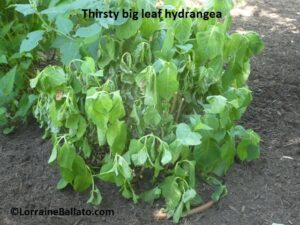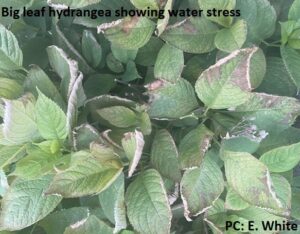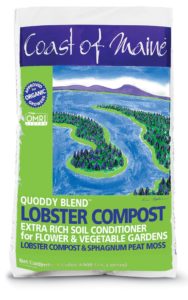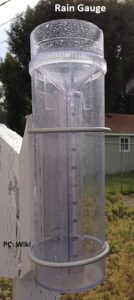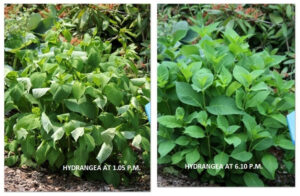A drought stricken hydrangea is heartbreaking – at least to me. This summer has had a dramatic impact on hydrangeas. If you didn’t monitor them daily to hydrate them, you might be heading for some losses. Which is what I am reading about and hearing from some of you.
WHAT TO DO IF YOUR HYDRANGEA LEAVES ARE CURLED AND DRIED UP
The most important thing you should do for a drought stricken hydrangea is continue to irrigate your plant until the season closes. They may put out new foliage but that’s iffy. Let the leaves drop on their own – don’t manually remove them.
THE WISDOM OF ADDING COMPOST AND MULCH
In addition to watering, you can help your drought stricken hydrangea by doing two other things. One is to add compost to the base of your plants as it helps retain moisture without water logging your plant. Plus the beneficial microbes will help your plant recover, if that’s possible. The other thing to do is be sure you have at least 2″ of mulch at the base of each plant, again to reduce moisture loss and protect the roots.
HOW DO I KNOW HOW MUCH WATER TO GIVE MY HYDRANGEAS
To prevent further drought impact on your plants, now might be a good time to figure out how much water each plant needs. It can be different depending on where the plant is sited and soil composition at that site, plus of course the weather. Get proficient at doing a “knuckle test”: put your finger into the ground at the base of the plant within the drip line. Your finger should be at least damp at the second knuckle. If not, water the plant. Then do the “knuckle test” again after about an hour or so to see if in fact there is enough moisture in the soil. If not, repeat. You can then learn and adjust your watering schedule based on that data.
THE BENEFITS OF A RAIN GAUGE
Also get a rain gauge. That info will add to the data you accumulate about the water needs of your plant. As an example, we woke up Sunday morning to see the dense flowers on our panicle hydrangeas bent over like old ladies. The only thing that could do that is a heavy rainfall. Although it wasn’t predicted, our rain gauge measured 1.3” of overnight rain and my rain barrel had overflowed. But my joy was short lived. Although I was relieved of home watering duty that morning, no such rain fell on the local volunteer garden one town over. So I was back hand watering yet again.
USING HYDRANGEA FOLIAGE TO DETERMINE YOUR PLANT’S WATER NEEDS
Most of us monitor the foliage on our hydrangeas to determine moisture needs but that can be deceptive. A hydrangea that is wilted at 1 p.m. from morning sun should recover in a few hours after the sun is off it — if of course, there is enough moisture in the surrounding soil which it then can take up. Jumping the gun and watering it before that recovery period can drown the roots and kill the plant. Again, a knuckle test and observation will be of great help.
WHAT SHOULD YOU DO TO PREVENT DROUGHT IMPACT ON HYDRANGEAS
Occasional absences/vacations especially during droughts can dramatically affect the viability of hydrangeas. You can hire someone to water for you, teaching them how much is enough vs. too much. Or you can consider soaker hoses on timers, or a sophisticated drip irrigation setup with moisture monitors – expensive and involved. But very effective.
ACTION PLAN FOR DROUGHT STRICKEN HYDRANGEAS
So what to do now for your drought stricken plant? NOTHING TO STIMULATE IT. Recovery is the name of the game. No fertilizer, no pruning, etc. About the only thing to do in addition to irrigating is to monitor for leaf spots and fungal diseases. You can get the low down on that HERE.
Be prepared to lose some plants which you won’t know until next spring when they leaf out. Keep in mind the key elements for hydration are soil, siting, and irrigation, not to mention weather. So maybe consider doing some transplanting next spring once you know which drought stricken plants survived.
Thanks for reading.
6 Secrets for Stunning Hydrangea Flowers
Get my FREE mini-guide with 6 fool-proof tips showing how to grow hydrangeas that produce the most amazing flowers.
No spam - I promise!
